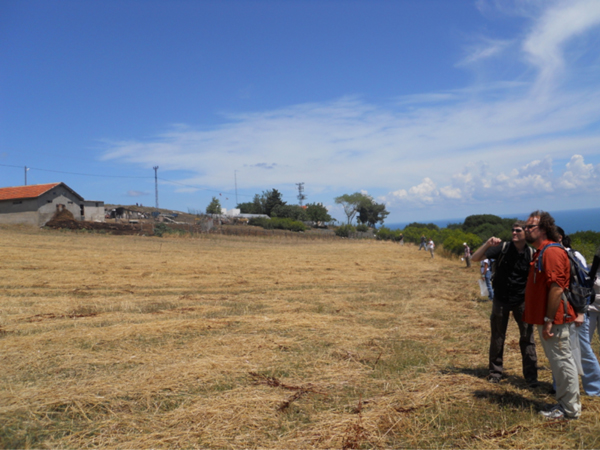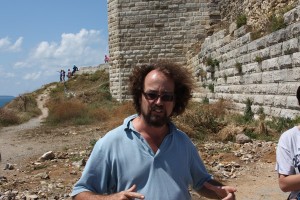CSUN Professor’s Work to Explore Origins of Sinop, Turkey

Art history professor Owen Doonan discusses archaeological survey strategy with colleague Alexander Bauer of Queens College, City University of New York. Photo courtesy of SRAP archive.
Archaeologist Owen Doonan, a professor of art history at California State University, Northridge, has spent the past 15 years exploring the history of the Sinop region of Turkey on the southern side of the Black Sea.
Doonan has already documented more than 400 historic sites, ranging from the Paleolithic to Ottoman eras across the rugged Sinop promontory. He has proposed to take his project one step further next summer when he leads a team of researchers, including CSUN students and possibly a couple of local public middle and high school teachers, on an excavation of what he believes is the acropolis of the earliest Ionian Greek colony to settle in the area more than 2,000 years ago and maybe the remains of the precincts of an early town that pre-dates the Greeks.
“If we find what I expect we will find, this will actually be a very revolutionary development for the understanding of the Black Sea going back 200 years of excavation to the time of Catherine the Great,” he said.
Doonan said he believes that fishermen who lived in the northern regions of the Black Sea follow the currents and fish to temporarily relocate to the Sinop region to continue their trade, and return to the north when the fish did. He expects the excavation this summer of an area under the parking lot of an old bus station to confirm his theory.
“When we peel off the pavement I already know that on the top, about 10 feet down, we will find items from the Byzantine period, and we know that because the Sinop Museum has done digging nearby and already found items that were about 1,000 years old,” Doonan said. “But, based on work our group did in 2000, I expect to find when we dig deeper, about 15 to 20 feet down, the remains of pit houses, about 20 feet across, and these belonged to the culture of people who lived in the northern ports of the Black Sea, not a local group.
“The way the fish migrate around the sea, some spawn up north and then circulate around the sea and by the summer they are down by Sinop, it seems that there were fisherman who established seasonal camps—coming down and going back home with the fish,” he said. “Much of the understanding of the development of the area places an emphasis on the Greeks settling near the Black Sea.
“But if we are right, then suddenly our understanding of the area changes. We will be able to show that the Black Sea people made these long voyages before the Greeks showed up and that the Greeks actually learned from them. Literally, we would be flipping history.”
Doonan’s Sinop Regional Archaeological Project and his related research has received support from the National Geographic Society, the United States’ National Endowment for the Humanities and the Alexander von Humbolt Foundation. He will be a Fellow at the Getty Villa this coming spring where he will contribute his research to their “Connecting Seas” program. He proposes to partner with the Turkish Ministry of Culture and Tourism and local government, culture and business organizations to conduct the excavations of the Sinop kale.

Art history professor Owen Doonan at the site of ancient Sinop. Behind him are 2,200-years-old walls. Photo by Gregory Thoma
Doonan said the project has two goals: establish the archaeological importance of the home of the philosopher Diogenes the Cynic and Mithridates Eupator, an arch rival of Rome; and create a set of monumental public spaces that will benefit the quality of life and cultural pride in the area, and perhaps serve as a tourism draw,
Underlying all of this is a secondary goal, at least for Doonan.
“For too long, those of us in academe did research for other academics,” he said.
“But really, we should be sharing with everyone. In archaeology, we should help tell the story of place in a way that people can understand and that will encourage interest of the right kind and an appreciation of what history can tell us.”
Doonan said that work can’t be confined to archaeological specialists. He said he wants to encourage students in disciplines across the CSUN campus, from art and history to Islamic studies and filmmaking, to join him on the excavation.
“True archaeology crosses disciplines and taps into a broad range of skills to tell a story,” he said. “Our project is an ideal place to expose students to a rich new culture and new ideas.”
He said he hopes to extend that opportunity to local primary and secondary teachers as well. “By taking part in the dig in the summer, they can go to their classrooms in the new ideas for teaching the sciences and social sciences in the fall,” Doonan said.
To learn more about the Sinop Regional Archaeological Project, visit the website http://www.nml.cuny.edu/srap/.

 experience
experience